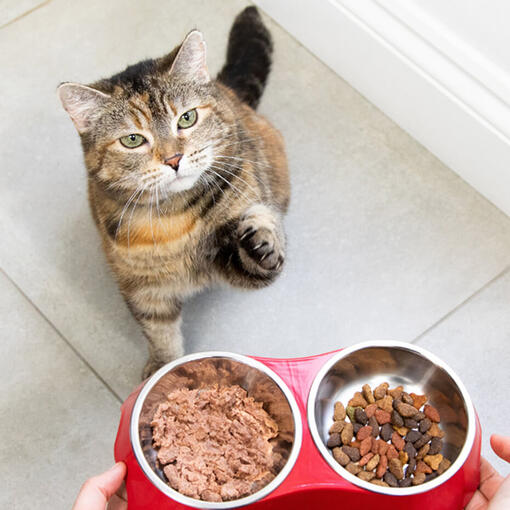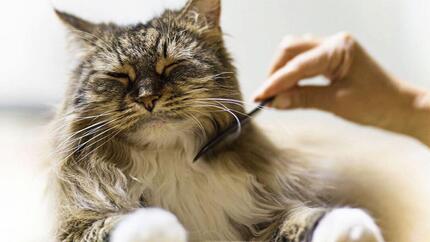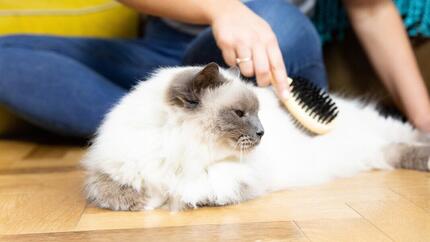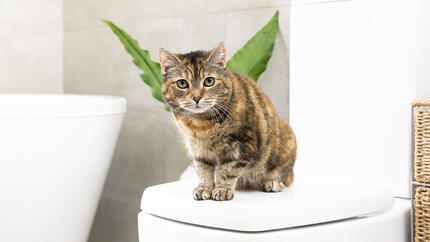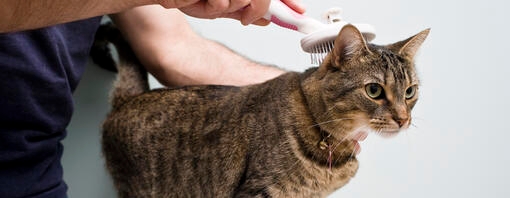
Cats seem to be some of the most resilient animals out there, from fearlessly climbing trees to always landing on their feet, so it’s no wonder we like to say they’ve got nine lives!
However despite this, as with all living beings, they can get a variety of ailments, and one of them is cat dandruff, the small, white flakes that fall off of dry skin. While dandruff is definitely unsightly, it can also cause real discomfort to your feline friend, especially if left untreated for extended periods of time.
Luckily, dandruff can be spotted early on, and with the right treatment, it can go away faster than you might think. To make sure you’re prepared, check out some of the potential causes and symptoms of cat dandruff, as well as a few tips on how to get rid of those annoying white flakes:
What causes dandruff in cats?
Dandruff is typically the result of your pet’s sebaceous glands producing too much or too little oil, causing a skin imbalance. Even though it’s a manageable condition, it’s important to figure out why your cat has this problem. However, there can be several reasons behind this condition.
An unhealthy diet
Good-quality food is paramount for a healthy and happy life, while an unbalanced diet, that is poor in fatty acids, can trigger dandruff in cats. Check that your cat’s food in good quality and contains omega fatty acids such as those found in fish oil or flaxseed which will definitely help improve cat skin problems such as dry skin.
Under- or over-grooming
It’s safe to say that cats are pretty clean animals given that they’re generally meticulous groomers. This is the reason why they don’t need to be bathed like dogs do. Brushing can also affect your cat’s skin if done too often so it makes sense to be mindful not to over-groom them. Also pay extra attention to see if your cat has become slower in their grooming habits lately or if, on the contrary, they have started excessively grooming. This is because both these behaviours can indicate that something might be wrong either clinically or behaviourally.
Low humidity
If you live in a dry environment and your cat is not getting enough hydration, this could also cause cat dandruff. Equally, living in an overheated space, during the colder months for example, might contribute to drier skin which could give rise to the problem of dandruff.
Seasonal or environmental allergies
Those of us with dust or seasonal allergies know the discomfort associated with exposure to these allergens when grass and tree pollen is everywhere, although some people are affected more than others. However, you might not know that it’s not uncommon for dandruff to be a symptom of these allergies in cats, and learning how to manage allergies in cats is important. Even so, it’s important to be aware that your cat might also be allergic to something in their food, so make sure to check that as a potential problem too.
Bacterial and fungal infections, and parasites
The culprit causing dandruff in cats could also be something more severe such as an infection or even parasites.
No matter what you think the cause of your cat’s dandruff might be, your first port of call should always be your vet so you can rule out – or treat – any clinical causes.
What’s the difference between dandruff and dander in cats?
The two terms sound similar but are in fact quite different. While dandruff is a skin condition in cats, the presence of dander is completely natural and is caused by the process of shedding dead skin cells. Plus, dander is almost microscopic so you probably wouldn’t even notice it in your cat’s fur.
What are the most common symptoms of dandruff in cats?
Dandruff is often accompanied by additional symptoms such as hair loss, itchiness, or skin redness. If you notice that your cat is grooming themselves more than usual, this could also point to a more significant issue that should be closely checked. Generally, if your cat seems unwell and is not their happy, playful self, it would be best to contact your vet for a check-up and a suitable cat dandruff treatment.
What’s a good cat dandruff treatment?
A balanced diet rich in omega 3 fatty acids should help with getting your cat’s skin back to normal. If the dandruff still won’t go away, you should also consider providing wet food, in case your cat doesn’t drink enough water on their own. Another solution might be getting a humidifier which would ensure that there’s enough moisture in the air for their skin to be properly hydrated.
Be careful with over-grooming as well: grooming your cat once every six weeks should be enough unless your cat doesn’t self-groom. However, if you suspect the issue is due to under-grooming, try brushing your pet a few times a week. This will help stimulate the skin to produce more oils and will remove the dead skin cells and excess hair.
To find out more about cat hygiene, our useful guide on everything you need to know about bathing cats can help.
To learn more about other skin issues your cat might develop, read our article about cat skin problems next.


